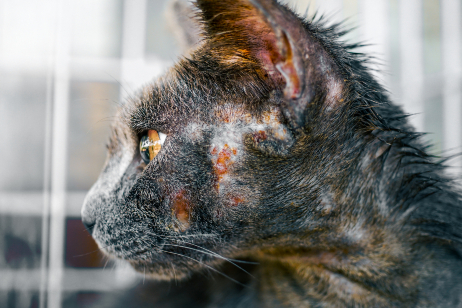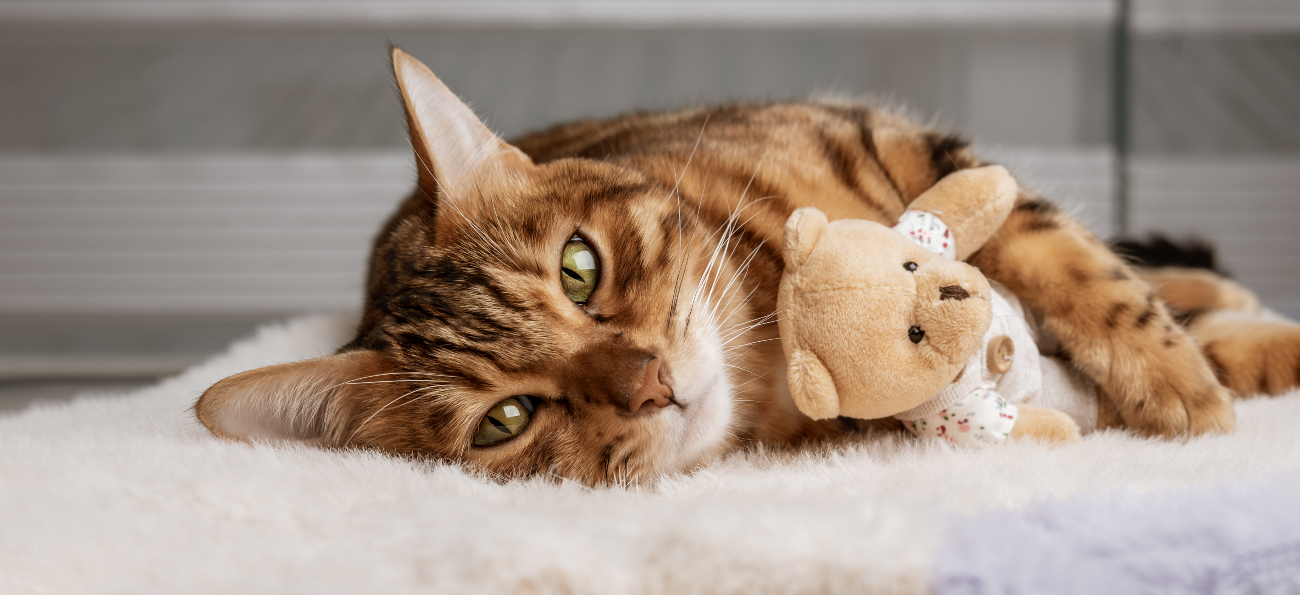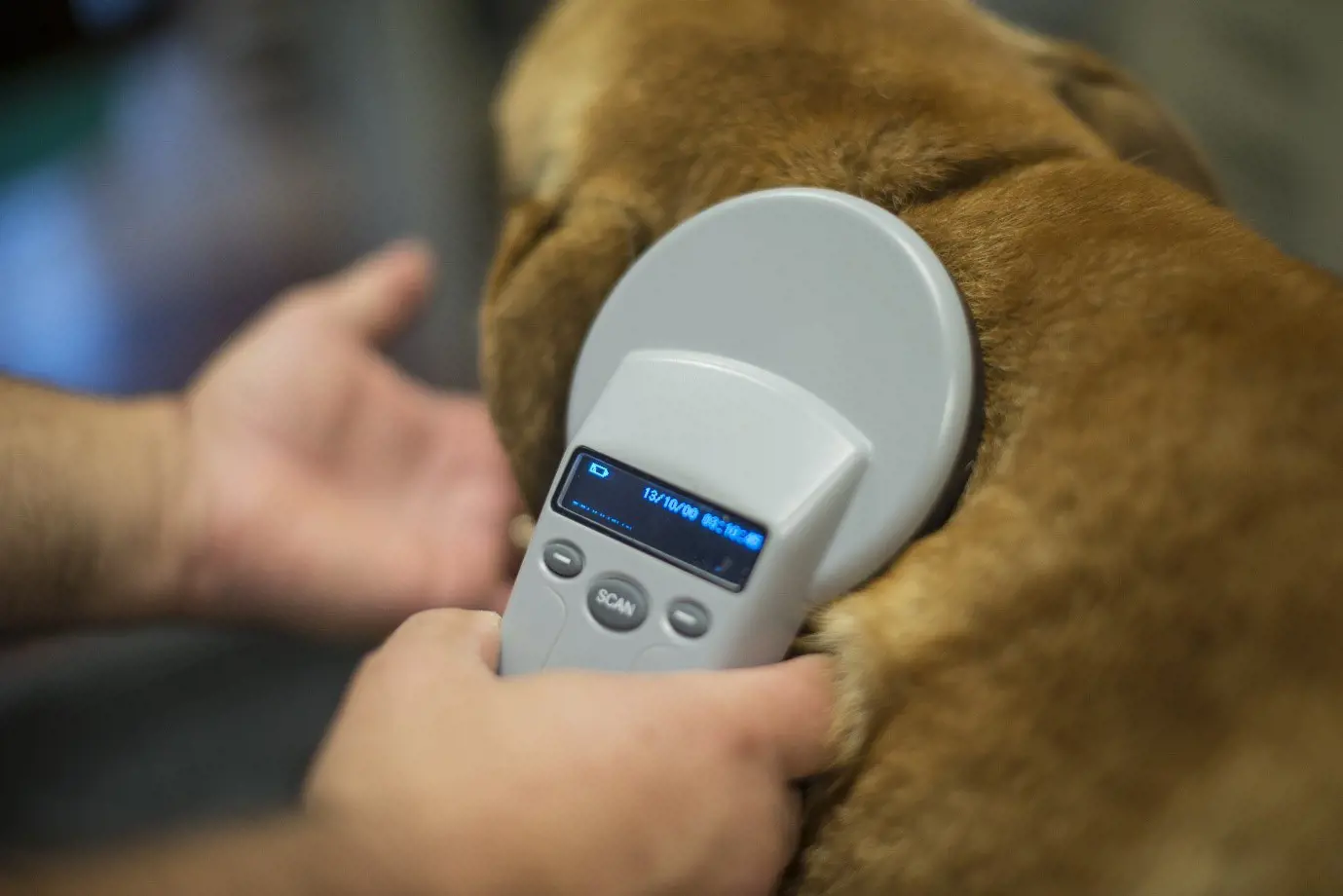Ringworm in cats: A comprehensive guide
9th February, 2024

Ringworm in cats is a common fungal infection that has nothing to do with worms, despite its misleading name. This condition, also known as feline dermatophytosis, can cause significant discomfort to our beloved feline friends and is a potential risk to humans as well, making it a matter of concern for every cat owner in the UK and beyond.
This guide will provide an in-depth look at the symptoms, effective treatment, and preventive measures for ringworm in cats, helping you ensure the health and happiness of your four-legged friend.
What is ringworm?
Ringworm, scientifically known as dermatophytosis, is a type of fungal infection that affects the skin, hair, and nails of cats. The term "ringworm" is derived from the characteristic circular rash that often appears on the skin of infected humans. However, the infection can present differently in cats, often resulting in hair loss and skin inflammation.
Contrary to its name, ringworm has no relation to worms. The fungi responsible for ringworm in cats are called dermatophytes, microscopic organisms that originate in soil but can thrive as parasites in animals and humans. These fungi feed on keratin, a protein found in hair, nails, and skin, leading to the characteristic symptoms of ringworm.
Causes of ringworm in cats
Ringworm is highly contagious and can be transmitted through direct contact with an infected cat or a contaminated object or surface. The hardy fungal spores can linger on items like combs, brushes, furniture, bedding, and carpets for up to 18 months, posing a risk of ringworm infection.
Kittens and older cats with weakened immune systems are at a higher risk of contracting ringworm. Cats that live in densely populated environments, like animal shelters, or those that roam outdoors are also more susceptible to the infection.
Symptoms of ringworm in cats
The symptoms of ringworm in cats can vary, making it a tricky condition to identify. The most common signs are:
- Circular areas of hair loss
- Broken and stubbly hair
- Scaling or crusty skin
- Inflamed areas of skin
- Excessive grooming and scratching
- Infected claws or nail beds
- Dandruff
However, it is worth noting that not all infected cats will display these symptoms. Some cats, especially those with long haired cats, may carry the infection without showing any signs, yet they can still spread the disease to other animals and people.
Diagnosing ringworm in cats
If you suspect your cat might have ringworm, you should consult a veterinarian for a definitive diagnosis. The vet may use an ultraviolet light known as a Wood's lamp to examine your cat's coat. Under this light, a fungus-infected hair may glow with a yellowish-green hue.
Microscopic examination of infected hairs from the affected area can also be conducted to look for fungal spores. For a more accurate diagnosis, the vet may take samples of your cat's hair and skin for a fungal culture test. This test may take up to three weeks to yield results, but it's considered the most reliable method for diagnosing fungal infections.
Treatment for ringworm in cats
Ringworm in cats can be effectively treated with a combination of a topical treatment and an oral medication. Topical treatments, such as anti fungal shampoo, creams, and ointments, can be applied directly to the infected areas. In cases where the infection has spread across the cat's body, a full-body rinse or dip may be used.
Oral medications, like itraconazole or terbinafine, are administered to combat the fungal infection systemically. Treatment duration varies, but it typically lasts for a minimum of six weeks.
It is important to adhere to the prescribed treatment schedule and not to stop the treatment unless advised by the vet. Ending the treatment prematurely could result in the recurrence of the infection.
Managing ringworm in multi-cat households
If you have more than one cat in your household and one of them gets diagnosed with ringworm, it's a good idea to get all your cats checked. Asymptomatic cats can still spread the infection, so it's crucial to identify and treat all infected cats.
During the treatment phase, try to isolate the infected cats from the healthy ones to prevent further spread of the infection.
Regular cleaning and disinfection of your home, particularly the areas where your cats spend most of their time, can also help control the spread of the fungal spores.
Environmental management for cats with ringworm infections
In order to minimise the likelihood of individuals and other household pets experiencing environmental contamination, it's essential that you adopt proactive measures in your dwelling as well as any areas frequented by your cat.
Constant hoovering and sanitising, and even recovery - are vital steps towards reducing the number of infectious spores present in one's surroundings. It would be best if you wiped every surface that isn't possible to vacuum with a cleaning agent boasting fungicidal properties mentioned on its label.
After vacuuming, ensure to discard used bags immediately and either dispose of or bleach, clean and disinfect soiled rags. All bedding should be thoroughly cleaned and disinfected in addition to any tools utilised for cat care such as grooming brushes.
If unsure about what product is appropriate for use, consultation with members of your vet team can provide valuable guidance.
Preventing ringworm in cats
Preventing ringworm is primarily about maintaining a clean and hygienic environment for your cat. Regularly clean and disinfect your cat's grooming tools, bedding, and other items they frequently come in contact with.
If your cat has been diagnosed with ringworm, follow your vet's advice on the duration and frequency of treatment to ensure a full recovery and to prevent a recurrence.
Moreover, regular health checks can help detect and treat ringworm early, reducing the chances of it spreading to other pets or humans in your household.
Ringworm in cats and humans
Ringworm is an important zoonotic disease, which means it can be transmitted from animals to humans. This is particularly concerning for people with compromised immune systems, including young children and the elderly.
If you or anyone in your household develops symptoms of ringworm, such as circular, itchy, red skin lesions, seek medical attention promptly. While ringworm in humans usually responds well to treatment, the fungal spores can remain infectious in the environment for up to 18 months, posing a risk of reinfection.
Can ringworm in cats go away on its own?
While it's true that a cat's immune system can eventually overcome a ringworm infection, treatment is highly recommended.
Without treatment, ringworm can continue to spread to other pets and humans, if the infection persists in the environment for an extended period.
How long does ringworm in cats last?
With appropriate treatment, most cats will recover from ringworm within a few weeks. However, the duration of the infection can vary depending on the severity of the condition and the cat's overall health. Some cases may require several months of treatment.
How long will my cat be contagious with ringworm?
The answer isn't straightforward, as the contagion period can vary. Typically, a cat can remain contagious for about three weeks if aggressive treatment is implemented. However, in less ideal situations where treatment has been delayed or is not effective, the cat may remain contagious for an extended period.
It's important to note that ringworm spores can remain active in the environment for over a year, which can cause reinfection if not properly cleaned. Therefore, it's crucial to not only treat your cat but also carry out a thorough cleaning of your environment to ensure all traces of the infection are eradicated.
Can I catch ringworm from my cat?
Yes, ringworm in cats can be transmitted to humans. It's important to minimise direct contact with an infected cat and to thoroughly clean and disinfect your home to prevent the spread of the fungal spores.
Getting cat insurance for your furry friend
While ringworm in cats is generally treatable, it serves as a reminder of the potential health issues your feline friend can face. Considering this, it's wise to consider getting cat insurance to help cover the costs of veterinary care in case of illness or injury.
With a comprehensive cat insurance policy*, you can ensure your cat receives the best possible care without breaking the bank. To get a cat insurance quote for your furry friend, simply visit our website. If you'd prefer to talk to one of our team members, feel free to give us a ring at 0330 102 5748. We are always here to support you and your feline friend.
*Preventative treatments are not covered by pet insurance policies for example: vaccinations, fleas, ticks and ringworms.
Conclusion

Ringworm in cats is a common yet treatable condition. With timely diagnosis and proper treatment, your cat can recover fully and continue to lead a happy and healthy life. As always, maintaining a clean environment and ensuring regular veterinary check-ups are crucial to your cat's overall health and wellbeing.
Remember, while ringworm is a manageable condition, it can be a hassle. So, take the necessary steps to prevent it, and consider investing in a comprehensive cat insurance policy to safeguard your feline friend's health in the long run.
With the right knowledge, precautions, and care, you can keep your cat safe from ringworm and provide them with a comfortable, wholesome life that they truly deserve.
Helpful Pages
Recent Posts
Pet Insurance Quote
- 98% claims paid *
- Claims paid directly to vets
- 24/7 vet video consultations
- Interest free monthly payments




